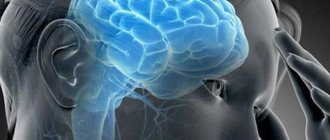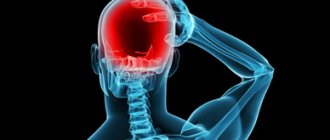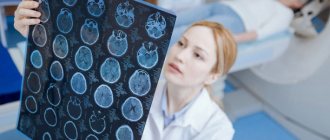A concussion is a reversible disruption of brain function that can occur as a result of an injury. In medicine, it is believed that with this condition, the connection between the nerve cells of the brain is disrupted. The main causes are sports, industrial and domestic injuries, and road traffic accidents. It is concussion that prevails among all types of traumatic brain injuries.
What happens to the brain when struck?
In a joint work, scientists from the United States and Sweden simulated the brain to show how it oscillates under severe impact. According to the results of the study, it became clear that the organ receives its damage not when it hits the skull, but due to compression and stretching of tissues that occur during vibrations of different frequencies.
Content:
- What happens to the brain when struck?
- Signs of a concussion
- How to Diagnose a Concussion
- How does a concussion manifest in children and the elderly?
- Treatment of concussion
- What drugs are prescribed
- Prognosis of this disease
Contrary to popular belief, the danger to the brain is not the hard skull, but the tissues themselves. For example, in boxing, during a blow to the head, the brain is injured much more than when the body suddenly stops. In addition, during a concussion, the brain is damaged to a greater extent from the inside, but the outer layer is not affected as much.
Scientists have conducted some studies in which collisions between American football players were observed. There were 189 cases in total. The players had sensors built into their helmets, with the help of which scientists were able to obtain data on the acceleration and change in the position of the head at the moment of impact.
It was found that after impacts, strong vibrations of the brain occur, the duration of which is a fraction of a second. Experts were able to sort these vibrations into frequencies, after which they found out that the strongest ones occur at a frequency of approximately 30 hertz. This can be compared to the strings of the second and third keys of a piano. Considering the situation in general, we can say that vibrations that occur with a frequency of less than 33 Hertz take 75% of the impact energy.
In addition, it was found that strong impacts provoke strong vibrations. For example, after a violent collision in which a team player fell and lost consciousness, the corpus callosum, located between the hemispheres of the brain, changed at a higher frequency than the surrounding tissue. And this led to severe deformation.
According to scientists, such modeling can be useful in the design of helmets that can suppress low-frequency vibrations that are dangerous to the brain.
Causes
The main and only factor in brain contusion is TBI. Doctors cite varying degrees of alcohol intoxication as a common and concomitant cause of head injury. Alcohol is related to accidents on the road, at home, and at the enterprise. This statistics is inaccurate, since patients with head injuries in the stage of alcohol intoxication do not go to a medical institution on the same day.
Complex head trauma occurs under extreme circumstances:
- at home;
- in an accident;
- in children's games;
- in criminal episodes;
- in production;
- while playing sports;
- during an epileptic attack.
Let's consider each case in more detail.
- A sign of a domestic incident is an injury resulting from careless housework. It is especially common to fall from a height onto a bulky, hard piece of home furnishings.
- In case of an accident on the roads, injury occurs to both the driver of the car and the pedestrian on foot. This happens especially often in winter - during icy conditions, fog and precipitation.
- Trauma in children is quite common. This occurs due to the anatomical structure and age-related characteristics of the skull. It is the largest and heaviest part of the child’s body, and is therefore susceptible to a high level of injury. The percentage of sad statistics of deaths in young children is very high. This is the most common injury in children under 5 years of age.
- In forensics, head contusions occur due to deliberate impact on the skull. Often, an injury occurs after being hit by a large object or resulting from a fall on it.
- Industrial – injury during work occurs as a result of non-compliance with safety regulations. The reason is the lack of helmets that protect the head. The victims are often construction workers, miners, etc.
- Sports – is a consequence of playing sports – falls, blows, etc. This injury occurs in both professional athletes and beginners.
Signs of a concussion
Do not forget that a concussion is manifested by a disruption of its functioning. When receiving a blow, a person often loses consciousness.
Once the person regains consciousness, they will experience the following symptoms:
- rapid breathing;
- gagging and vomiting;
- fast or slow heart rate;
- memory impairment.
But, after some time, these factors disappear. Blood pressure levels also stabilize, but in some patients they may increase, and this depends not only on the injury received, but also on the severe stress experienced. It should be noted that during a concussion, body temperature does not increase.
The main signs of a concussion include:
- headache;
- nausea;
- dizziness;
- general weakness;
- flushes of blood to the face;
- noise in ears;
- increased sweating;
- insomnia.
After a concussion, a person's health improves after about a week. In rare cases, this happens after two weeks. Headache and other possible symptoms can last for a long time.
Complications
There are several consequences.
Manifestation of short-term disorder
Even after discharge from the hospital, where a person was treated for a head injury that caused a concussion, the pathological symptoms do not immediately go away. They appear as:
- severe dizziness;
- frequent migraines;
- difficulty concentrating ;
- problems that arise in the process of reading or writing.
The person continues to suffer from nausea and fatigue. Becomes weak and absent-minded. Drowsiness is constantly present.
If these signs do not stop within a month after receiving a traumatic brain injury, you should consider visiting your doctor again. Because if the disorders that have arisen that do not allow the brain to function normally are not treated, the consequences can be dangerous.
Postconcussion syndrome
The consequence of a concussion in the absence of timely treatment sometimes becomes post-concussion syndrome. Symptoms of the pathology can manifest themselves in the form of migraine attacks, sleep disturbances, and the presence of anxiety.
A person is unable to work normally because he cannot concentrate, concentrate on something that previously did not cause any problems. Even a slight load leads to severe fatigue. It is often accompanied by causeless anxiety and dizziness.
Why can our articles be trusted?
We make health information clear, accessible and relevant.
- All articles are checked by practicing doctors.
- We take scientific literature and the latest research as a basis.
- We publish detailed articles that answer all questions.
The syndrome often develops months later and can appear years after the concussion.
Post-traumatic encephalopathy
Repeated shock to the organ sometimes leads to complications in the form of post-traumatic encephalopathy. Athletes who practice boxing and participate in fist fights often suffer from this phenomenon. Development goes through several stages, during which:
- circulation is disrupted ;
- cerebrospinal fluid stagnates;
- nerve die ;
- connective tissues grow
- scars form adhesions form;
- activity decreases .
Which doctor should I go to with a concussion?
Many people experience a concussion throughout their lives.
Post-traumatic encephalopathy leads to the fact that a person becomes lethargic, arms or legs often tremble, consciousness is confused, problems arise with balance, convulsions appear, and changes in character are noticeable.
Asthenic syndrome causes anger, anxiety, and frequent outbursts of emotions. Mental abilities noticeably decrease; learning simple topics becomes quite difficult for a person.
The occurrence of autonomic disorders
A concussion can lead to problems with the supply of oxygen to tissues and organs, which causes autonomic disorders. They are accompanied by:
- headache attacks ;
- groundless worries;
- surges ;
- tachycardia;
- numbness of the limbs.
The person becomes lethargic, sometimes faints, gets tired quickly, and sweats a lot. He may have problems in his sex life.
Insufficient saturation of blood vessels with oxygen leads to interruptions in the functioning of the heart and the appearance of shortness of breath.
Damage to the autonomic system provokes the development of pathologies of the digestive organs and complicates the process of urination.
Development of cognitive disorders
The consequences of a concussion can manifest itself in impaired cognitive functions, which is accompanied by serious problems with memory and speech. A person forgets basic things, finds it difficult to find words, and loses the ability to think, analyze, and draw conclusions.
Any mental work becomes overwhelming, since new information is not perceived, and previous knowledge also disappears.
Mental damage
Lack of proper treatment after a concussion can affect the psyche. The human body is capable of responding to infection with an infectious pathology due to alcohol consumption with overexcitement and confusion.
Outbursts of rage and aggression towards others appear. An uncontrollable surge of emotions is replaced by remorse and a feeling of shame.
Bad mood prevails. Anger is provoked by any irritating factor. Euphoria occurs without a reason. A person often suffers from seizures and convulsions that resemble epilepsy. Fears and unreasonable worries begin to haunt. The condition becomes inadequate.
Changes that occur in the psyche entail apathy, shifts in thinking, loss of reality, and the development of dementia. The patient may be accompanied by hallucinations and delusions.
How to Diagnose a Concussion
It is important to clarify under what circumstances the event occurred and to establish in what condition the patient is. For example, this is a negative psychological impact or alcohol poisoning.
Immediately after the injury, you may notice nystagmus, twitching of the eyelids, impaired balance and coordination of movement. Other symptoms will appear much later. The patient must be hospitalized because the symptoms of a concussion may mask other, more serious brain injuries. The neurosurgery department will conduct an examination and monitor the patient’s further condition.
So, if you receive a brain injury, you must immediately go to a medical center. There the patient will be examined by a traumatologist and neurologist. Specialists will take an X-ray of the skull to make sure there are no bone fractures. If necessary, a magnetic resonance imaging or computed tomography scan of the brain will be performed. The ophthalmologist must give his opinion. The examination results will help determine the severity of the injury. The patient is then admitted to a hospital for further treatment or prescribed a therapy regimen and sent home.
Kinds
When making a diagnosis, a division is made according to the number and size of the damage that has occurred:
- Severe brain contusion is a form that, according to statistics, leads to about 50% of deaths due to head trauma. Patients with this diagnosis are rehabilitated over the course of a year and not always to the end;
- Moderate brain contusion is often combined with a fracture of the base and vault of the skull, hemorrhage from a ruptured aneurysm;
- Mild brain contusion - TBI with favorable consequences and further restoration of the injured person’s health, does not pose a threat to his life.
These forms of trauma have their own picture, symptoms, specific treatment, on which the subsequent scenario of the patient’s life and the characteristics of his life depend.
How does a concussion manifest in children and the elderly?
Symptoms of a concussion vary depending on the patient's age.
In infants and young children, when they receive a concussion, consciousness is practically not impaired. At the time of injury, you may notice pale skin, rapid heartbeat, lethargy, and drowsiness. When feeding, regurgitation occurs, vomiting occurs, the child becomes restless, drowsy, or, on the contrary, sleeps poorly. After about three to four days, all signs disappear.
Preschoolers are less likely to lose consciousness, and they recover within two to three days.
Elderly people and the elderly may also not lose consciousness, just like children. They experience disorientation in space and time. The headache becomes throbbing and occurs most often in the back of the head. The pain can last for a week, and it gets worse if the person suffers from high blood pressure and dizziness.
Treatment of concussion
The first aid that should be provided to the victim is as follows: the conscious person should be placed horizontally on his back and his head raised slightly.
If the patient has not regained consciousness, then he should be turned on his right side so that his face is turned to the ground. Bend your left arm and leg at an angle of 90°. Before doing this, you need to make sure that the person did not suffer bone fractures when falling. If they are present, then you cannot turn it over, but you need to urgently call an ambulance.
If everything is fine and there are no fractures, then this position of the body helps oxygen easily pass into the lungs, and excess fluid will flow out of the mouth (the tongue will not retract, and blood, saliva or vomit will not enter the respiratory tract).
If the patient has a broken head, it is necessary to apply a bandage.
As mentioned earlier, when the ambulance arrives, the person is hospitalized. Already at the clinic he is diagnosed and given the necessary therapy.
The patient is prescribed bed rest for three days. Later, taking into account the characteristics of the injury, it can be extended to five days. If after this time no complications have arisen, then the patient is discharged to continue outpatient treatment, which will last two weeks.
Severity of TBI
For some people, the consequences of a traumatic brain injury may include frequent headaches, while for others it can be much more complicated, even leading to complete disability. This is influenced by certain factors:
- Severity. The more serious the injury and the deeper its penetration, the more difficult the patient’s recovery.
- Health care. The faster the injured person receives qualified medical care, the greater the chances of a successful recovery with minimal or no consequences.
- Age of the victim. The older a person is, the more difficult it is for his body to cope with such an injury.
The severity of TBI is characterized by: mild, moderate, severe. Based on statistical studies, in people under 20 years of age there are no consequences at all after a slight head injury. In cases where the victim is over 60 years old and the severity of the traumatic brain injury is severe, the probability of death is 80%. If you do not seek medical help as soon as possible, complications of a traumatic brain injury cannot be avoided.
What drugs are prescribed
Magnesia is the most commonly prescribed medication; rest and sleep play an important role in treatment. Medicines are needed to relieve headaches, dizziness, anxiety, insomnia and other symptoms.
Best materials of the month
- Coronaviruses: SARS-CoV-2 (COVID-19)
- Antibiotics for the prevention and treatment of COVID-19: how effective are they?
- The most common "office" diseases
- Does vodka kill coronavirus?
- How to stay alive on our roads?
Therefore, the patient is recommended to take painkillers, sedatives and sleeping pills (preferably in tablet form).
As a pain reliever, the following are prescribed: Analgin, Sedalgin, Pentalgin. Sedatives are: Valerian, Corvalol, Valocordin, Motherwort. The most commonly used tranquilizers are: Sibazon, Afobazol. Donormil and Relaxon will help you get rid of insomnia.
To quickly and completely restore the functioning of the brain, it is necessary to undergo a full course of metabolic and vascular therapy. In this case, it is best to combine vascular drugs with nootropic drugs (Cavinton, Glycine, Noopept).
In order to prevent the development of possible complications in time, you should undergo clinical observation for one year by a neurologist at your place of residence.










